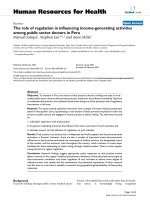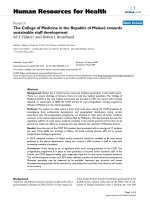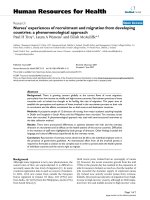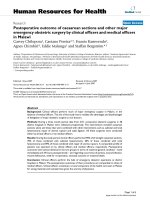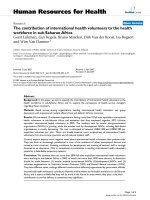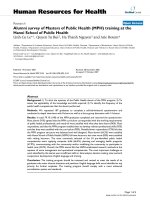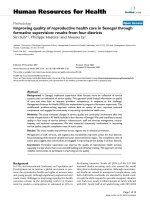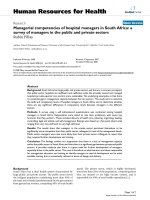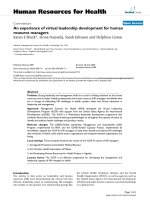báo cáo sinh học:" Systematic inclusion of mandatory interprofessional education in health professions curricula at Gunma University: a report of student self-assessment in a nine-year implementation" ppt
Bạn đang xem bản rút gọn của tài liệu. Xem và tải ngay bản đầy đủ của tài liệu tại đây (323.41 KB, 8 trang )
BioMed Central
Page 1 of 8
(page number not for citation purposes)
Human Resources for Health
Open Access
Research
Systematic inclusion of mandatory interprofessional education in
health professions curricula at Gunma University: a report of
student self-assessment in a nine-year implementation
Hatsue Ogawara
1
, Tomoko Hayashi
2
, Yasuyoshi Asakawa
3
,
Kiyotaka Iwasaki
4
, Tamiko Matsuda
2
, Yumiko Abe
1
, Fusae Tozato
3
,
Takatoshi Makino
2
, Misako Koizumi
2
, Takako Yasukawa
3,5
and
Hideomi Watanabe*
3
Address:
1
Department of Laboratory Sciences, School of Health Sciences, Gunma University, Gunma, Japan,
2
Department of Nursing, School of
Health Sciences, Gunma University, Gunma, Japan,
3
Department of Physical Therapy, School of Health Sciences, Gunma University, Gunma,
Japan,
4
Department of Occupational Therapy, School of Health Sciences, Gunma University, Gunma, Japan and
5
Department of Internal
Medicine, Seirei Hamamatsu General Hospital, Shizuoka, Japan
Email: Hatsue Ogawara - ; Tomoko Hayashi - ;
Yasuyoshi Asakawa - ; Kiyotaka Iwasaki - ;
Tamiko Matsuda - ; Yumiko Abe - ; Fusae Tozato - ;
Takatoshi Makino - ; Misako Koizumi - ;
Takako Yasukawa - ; Hideomi Watanabe* -
* Corresponding author
Abstract
Background: The mandatory interprofessional education programme at Gunma University was initiated
in 1999. This paper is a statistical evaluation of the programme from 1999 to 2007.
Methods: A questionnaire of 10 items to assess the achievement levels of the programme, which was
developed independently of other assessment systems published previously, was distributed, as well as two
or three open-ended questions to be answered at the end of each annual module. A multivariate analysis
of variance model was used, and the factor analysis of the responses was performed with varimax rotation.
Results: Over all, 1418 respondents of a possible 1629 students completed the survey, for a total
response rate of 87.1%. Cronbach's alpha of 10 items was 0.793, revealing high internal consistency. Our
original questionnaire was categorized into four subscales as follows: "Role and responsibilities",
"Teamwork and collaboration", "Structure and function of training facilities", and "Professional identity".
Students in the Department of Occupational Therapy reached a relatively lower level of achievement. In
the replies to the open-ended questions, requests for the participation of the medical students were
repeated throughout the evaluation period.
Conclusion: The present four subscales measure "understanding", and may take into account the
development of interprofessional education programmes with clinical training in various facilities. The
content and quality of clinical training subjects may be remarkably dependent on training facilities,
suggesting the importance of full consultation mechanisms in the local network with the relevant
educational institutes for medicine, health care and welfare.
Published: 23 July 2009
Human Resources for Health 2009, 7:60 doi:10.1186/1478-4491-7-60
Received: 3 March 2009
Accepted: 23 July 2009
This article is available from: />© 2009 Ogawara et al; licensee BioMed Central Ltd.
This is an Open Access article distributed under the terms of the Creative Commons Attribution License ( />),
which permits unrestricted use, distribution, and reproduction in any medium, provided the original work is properly cited.
Human Resources for Health 2009, 7:60 />Page 2 of 8
(page number not for citation purposes)
Background
In 1988, the World Health Organization (WHO) identi-
fied multiprofessional education as the process by which
students and practitioners from various health profes-
sions learn together with the goals of interaction and col-
laboration in providing health promotion, disease
prevention, curative services, rehabilitation and palliation
[1]. A recent report from a nurse-coordinated, multidisci-
plinary, family-based, ambulatory programme
(EUROACTION) demonstrated that healthier lifestyles
and improvement in risk factors were achieved among
patients with coronary heart disease and those at high risk
for cardiovascular disease and their partners as compared
to standard care, indicating the usefulness of interprofes-
sional working (IPW) [2].
Interprofessional education (IPE) plays an important role
in the acquisition of an attitude for IPW in graduate and
undergraduate students [3]. Recently there has been an
explosion of interest in IPE on the part of academic insti-
tutions around the world [4]. To plan and perform IPE
activities effectively, the characteristic culture of the coun-
try as well as the norms, strengths and constraints of the
academic institutes must be taken into account. Unique
IPE must be adapted for each educational setting in each
country.
In Gunma University, the School of Health Sciences was
incorporated from the junior college department into the
Faculty of Medicine in 1996. For the faculty integration,
one of the most important aspects of education has been
IPE. A few years were spent in preparing for the educa-
tional system development, and the original and distinc-
tive IPE was delivered to the third year of undergraduate
students for the first time in 1999.
The mandatory IPE practice-training curriculum, desig-
nated as "Simulated interprofessional training among stu-
dents of different professions in health sciences", has been
implemented continuously for over 10 years. A systemic
assessment for the achievement was developed independ-
ently of those described elsewhere [5,6], and we reviewed
the effectiveness of the curriculum from a team-building
point of view. The present IPE programme has thus far
been planned, implemented and evaluated independ-
ently of scientific research.
The present educational programme has been approved as
a "Support Programme for Distinctive University Educa-
tion" by the Ministry of Education, Culture, Sports, Sci-
ence and Technology (MEXT). With this financial support,
in the present paper, the effectiveness and the limitations
were elucidated statistically using our own assessment
measures, and will be discussed in comparison with the
literature.
Methods
GUSHS curriculum guidelines
Gunma University School of Health Sciences (GUSHS),
which provides interprofessional curricula for students
majoring in nursing (NS, 80 students), laboratory sciences
(LS, 40 students), physical therapy (PT, 20 students) and
occupational therapy (OT, 20 students), was upgraded
from the junior college department and incorporated into
the Faculty of Medicine in 1996.
The IPE programme in GUSHS consists of two types of
subjects. One type is a lecture style, which includes two
subjects delivering information to first-year students and
teaches the details and value of IPW. These lecture-style
subjects are "Holistic Medicine/Teamwork Studies", a
mandatory basic science, provided in the first term, and
"Interprofessional Work Overview", an elective course in
general education in the latter term, totalling 15 lessons
for each subject. Another is a training-based subject called
Teamwork Training. Building on the professional exper-
tise acquired in the second year, third-year students partic-
ipate in this mandatory training subject, a core
programme of our IPE. The third-year students also learn
clinical skills. In both third- and fourth-year students,
clinical training subjects and research for a graduation
thesis are provided. Thus, the GUSHS provides compre-
hensive health professions education curricula that are
well balanced between specialized clinical education and
holistic medical approaches.
Contents of the subject "Teamwork Training"
This IPE training, consisting of 45 two-hour lessons con-
ducted throughout the third academic year, has been pro-
vided for 10 years, since the 1999 academic year. The
flowchart of IPE in GUSHS is shown in Figure 1. After a
short orientation, teams of students from different depart-
ments were allocated to the training facilities through
games.
The design of the training agenda and planning of the
clinical training were developed through several group
consultations. Clinical training was then implemented
outside the university at the assigned training facilities for
two full days.
Approximately 20 facilities were asked to cooperate with
the clinical training outside the university, selected from
the following seven fields: "Hospital Medicine", "Com-
munity Health Care", "Care at Home", "Rehabilitation",
"Medical Care for the Mentally Ill", "Paediatric Care" and
"Elder Care". These facilities have played a major role in
delivering diversified health care services.
After this clinical training, several group consultations
were held to prepare a report on achievements and lessons
Human Resources for Health 2009, 7:60 />Page 3 of 8
(page number not for citation purposes)
learnt, which were presented at a debriefing meeting. The
debriefing meeting of the "Teamwork Training" course
was held, consisting of each group's presentation and gen-
eral discussions, and then several group consultations
were held to prepare clinical training reports for a brief
report book.
The management body, designated as the Interprofes-
sional Education Committee of Gunma University (IPEC-
GU) consists of two professors from GUSHS and four
associate professors. The Committee contacts the selected
training facilities, prepares an annual plan, organizes pre-
paratory and management meetings, supervises academic
staff who implement training with students, establishes
standards for evaluation, conducts and analyses the "post-
training evaluation surveys" and compiles reports on
training.
Approximately 20 academic staff selected from the four
departments facilitated the students' training groups
according to the educational guidelines. A training group
consists of eight students: four from the Department of
Nursing, two from Laboratory Sciences, and one each
from Physical Therapy and Occupational Therapy, which
is proportional to the enrolment capacity of each depart-
ment.
Assessments of the IPE programme by students
To assess achievement levels of IPE in GUSHS, a question-
naire survey was conducted on 1629 undergraduate stu-
dents during the nine years from 1999 to 2007, and 1418
respondents completed the survey. The numbers of
respondents were as follows: nursing (N, 690), laboratory
sciences (LS, 373), physical and occupational therapies
(PT, 180; OT, 175. Students were asked to complete a
short questionnaire with the following 10 items:
1. organization of the facility
2. function of the facility
3. roles of each profession in the facility
4. operations and tasks of each profession in the facility
5. collaboration among professionals working in the facil-
ity
6. your profession's role and uniqueness
7. teamwork experienced in the training facility
8. membership and leadership in group activities
9. teamwork required in various fields
10. importance of teamwork.
Students rated each question on a four-point scale of
understanding, ranging from; "I fully understood" (4), "I
Flowchart of IPE implementation in GUSHSFigure 1
Flowchart of IPE implementation in GUSHS.
Overall Guidance and Group
formation
Group works:
Planning of the clinical training
Clinical training
outside the University
Group works:
Preparation of reports and
Presentations
Debriefing meeting:
Presentations and discussion
2 whole days
Group works:
Submission of reports
Human Resources for Health 2009, 7:60 />Page 4 of 8
(page number not for citation purposes)
understood"(3), "I did not understand well" (2), and "I
did not understand at all"(1) – two positive and two neg-
ative responses, respectively. Two or three open-ended
opinions at the end of each IPE module were also
obtained.
Statistical analysis
A multivariate analysis of variance (MANOVA) model was
used, and then factor analysis of the responses was per-
formed with varimax rotation by means of the Statistical
Package for the Social Sciences (SPSS, version 16.0J). This
procedure was used both to reduce a large dataset and to
identify clustering items in the scale. Scrutiny of the clus-
tered items enabled hypothetical inferences to be made
about relationships between variables. Measures of inter-
nal consistency (coefficient alpha) of subscales and items
were obtained using standard psychometric evaluation
procedures. Significance levels were set at p values less
than 0.05.
Results
Overall, 1418 respondents of a possible 1629 completed
the survey, for a total response rate of 87.1%. Cronbach's
alpha of 10 items was 0.793, revealing a high rate of inter-
nal consistency.
Factor analysis of the responses
The "Department belonged to" was added to the 10 items
of the questionnaire as another item, and points from one
to four were given for each department in descending
order according to the mean score of total questions in the
department; i.e., 1 for Department of Nursing (mean
score of 3.440), 2 for Laboratory Sciences (3.393), 3 for
Physical Therapy (3.366), and 4 for Occupational Therapy
(3.259). The factors were examined after varimax rotation.
Items with loadings less than 0.4 and those with loadings
over 0.4 that appeared in more than one factor were dis-
carded. As a result, one item, Q7-"Teamwork experienced
in the training facility", showing factors loading of higher
than 0.4 in two subscales, was removed. By factor analysis,
four subscales were obtained, as shown in Table 1. In the
four subscales, three corresponded well to those initially
named "Roles and responsibilities", "Teamwork and col-
laboration", and "professional identity", as described by
Parcell and Bligh [5], and another – "Structure and func-
tion of training facilities" – was new in the present study.
Subscale 1: Roles and responsibilities
The strongest item in the group was Q3 – "Roles of each
profession in the facility" – with a factor loading of 0.781.
This was followed by Q4, "Operations and tasks of each
profession in the facility" (0.621) and Q5, "Collaboration
among professionals working in the facility" (0.465).
Subscale 2: Teamwork and collaboration
Three items were involved in this subscale. The strongest
item in the group was Q9, "Teamwork required in various
fields", with a factor loading of 0.711. This was followed
by Q10, "Importance of teamwork" (0.500) and Q8,
"Membership and leadership in group activities" (0.451).
Subscale 3: Structure and function of training facilities
Two items contributed to this group with high scores. The
first was Q1, "Organization of the facility" (0.716), and
next was Q2, "Function of the facility" (0.701).
Subscale 4: Professional identity
Two items contributed to this group, being related to pos-
itive and negative aspects of professional identity. The
positively loaded item was Q6, "Your profession's role
and uniqueness" (0.532), and the negatively loaded item
was "Department belonged to" (-0.448).
Comparison of mean scores on the survey for four health
care students
In Figure 2, mean scores of individual items (Q1 – Q10)
were compared for four health care students. Three out of
ten items, Q3, Q5 and Q8, revealed no significant differ-
Table 1: Summary of factor analysis contributing to each subscale*
Subscale
Question number Items 123 4
3 Role of each profession in the facility 0.781 0.115 0.173 0.087
4 Operations and tasks of each profession in the facility 0.621 0.193 0.165 0.086
5 Collaboration among professionals working in the facility 0.465 0.283 0.139 0.137
9 Teamwork required in various fields 0.108 0.711 0.146 0.059
10 Importance of teamwork 0.163 0.500 0.053 0.129
8 Membership and leadership in group activities 0.128 0.451 0.092 0.014
1 Organization of the facility 0.150 0.152 0.716 0.086
2 Function of the facility 0.215 0.133 0.701 0.093
6 Your profession's role and uniqueness 0.316 0.207 0.103 0.532
Department belonged to -0.017 -0.019 -0.049 -0.448
*These data were analysed by the factor analysis method and the Kaiser's varimax method, by means of SPSS software.
Human Resources for Health 2009, 7:60 />Page 5 of 8
(page number not for citation purposes)
ence among four departments. In contrast, at Q6, "Your
profession's role and uniqueness", there were significant
differences among mean scores (mean and 95% confi-
dence interval (95%CI)) of four departments (all p <
0.001), as follows: N 3.41 (95%CI, 3.36 – 3.46), LS 3.17
(95%CI, 3.08 – 3.26), PT 3.02 (95%CI, 2.87 – 3.16) and
OT 2.78 (95%CI, 2.64 – 2.93).
It is noteworthy that in addition to this Q6, in five other
items OT students also showed lower points as compared
with other department students. The mean scores of OT
department students for Q1, "Organization of the facil-
ity", and Q2, "Function of the facility", were significantly
lower than those of NS and LS departments (p < 0.05). At
Q9, "Teamwork required in various fields", the mean
score of OT (3.09, 95%CI 3.00 – 3.17) was significantly
lower than NS (3.25, 95%CI 3.21 – 3.30) (p < 0.01) and
PT (3.31, 95%CI 3.22 – 3.41) (p < 0.01). For Q4, "Oper-
ations and tasks of each profession in the facility", there
was a significant difference between OT (3.37, 95%CI
3.28 – 3.46) and LS (3.52, 95%CI 3.46 – 3.58) (p < 0.05).
Also for Q7, "Teamwork experienced in the training facil-
ity", there was a significant difference between OT (3.22,
95%CI 3.12 – 3.33) and NS (3.39, 95%CI 3.34–3.44) (p
< 0.05).
Changes of the students' attainment over the years
The mean score of Q6, "Your profession's role and
uniqueness" overall (3.22, 95%CI 2.37 – 7.07) was the
lowest among 10 items and the scores of each department
showed relatively heterogeneous distribution (Figure 2).
The change of distribution of the attainment on Q6 dur-
ing the nine years from 1999 to 2007 was investigated and
the results are shown in Figure 3. The percentages of pos-
itive responses for "fully understand" and "understand"
changed from 71.5% in 1999 to 86.0% in 2007. When
mean scores of the surveyed year were compared by
MANOVA model, the mean score and 95% CI in 1999
(2.99; 95%CI 2.84 – 3.14) was significantly lower than
that in 2004(3.33; 95%CI 3.21 – 3.45), 2006 (3.30;
95%CI 3.17 – 3.43), and 2007 (3.32; 95%CI 3.19 – 3.44).
The mean scores during 2000/2007 were not significantly
different.
On the other hand, Q10, "Importance of teamwork" was
the highest score of all the other nine items, and the scores
of each department showed relatively homogeneous dis-
tribution (Figure 2). The mean scores were kept at a high
level throughout the years examined (Figure 4), and were
not significantly different during any of the periods evalu-
ated.
Open-ended opinions
Various opinions were obtained. Among them, requests
for medical students to join the practice were expressed
every year. For example, the statement was seen in 2006
as: "Collaboration with medical students is essential to
achieve teamwork-training goals. Students of nursing, lab-
Comparison of mean scores of each questionnaire in 4 health care departmentsFigure 2
Comparison of mean scores of each questionnaire in 4 health care departments. One, two or three asterisks indi-
cate significant difference, with p-value less than 0.05, 0.01 and 0.001, respectively.
䂾䇭NS
䃂䇭LS
Ƒ䇭PT
䂓䇭OT
***
*
*
*
**
**
***
*
*
**
**
***
***
***
Human Resources for Health 2009, 7:60 />Page 6 of 8
(page number not for citation purposes)
oratory sciences and physical and occupational therapies
would like medical students to join this training subject".
Discussion
The mandatory IPE practice-training curriculum in
GUSHS, designated as "Simulated interprofessional train-
ing among students of different professions in health sci-
ences", has been implemented continuously for more
than nine years. This educational programme was origi-
nally designed by us with two goals in mind: experiencing
being part of a health care team (the spirit of interprofes-
sional work), and learning interprofessional work in clin-
ical practice (skills of interprofessional work).
Mandatory practice training has been assessed with origi-
nal assessment tools. In the present study, four factor sub-
scales – "Role and responsibilities", "Teamwork and
collaboration", "Structure and function of training facili-
ties" and "Professional identity" – were obtained when
the questionnaire was analysed by factor analysis of the
responses using varimax rotation to confirm the validity
and reliability of questionnaires.
In 1999, Parcell & Bligh showed three subscales obtained
from an IPE assessment using 19 items [5]. This assess-
ment tool has been used widely for many types of IPE pro-
grammes; for example, in attitudes of health science
faculty members towards IPE with minor modification
[6]. It is of great interest that the present analyses reached
the same three subscales as those described by Parcell &
Bligh, i.e. "Role and responsibilities", "Teamwork and col-
laboration" and "Professional identity", although these
two assessments were accomplished in completely differ-
ent IPEs. These results suggest that the development of IPE
programmes should require at least these three independ-
ent aspects.
On the other hand, our results included another subscale,
"Structure and function of training facilities". The present
IPE programme in GUSHS includes a two-day clinical
training session at various types of facilities outside the
university in the fields of medicine, health and welfare,
while the assessment described by Parcell & Bligh did not
include questionnaire items assessing these types of facil-
ities [5]. These results suggest that the effectiveness and
quality of the structure and functions at the facility may
play an important role in the training-type IPE.
Surprisingly, the OT students showed lower points as
compared with other department students in six items.
The reason for the lower achievement of the IPE goals
observed in OT students is uncertain at present. The lower
comprehension of IPE in OT students might be unique to
our university, since in an IPE initiative report by John-
ston & Banks, no specific responses in OT students were
described [7].
Recently, in a survey of 162 Bachelor of Health Sciences
students, however, Hoffmann & Harnish reported a
decrease in student interest in pursuing their professions
after an IPE mandatory exercise by OT as well as nursing
and social work students [8]. The significance of IPE with
Change of distribution of achievement to "Your profession's role and uniqueness" during 1999/2007Figure 3
Change of distribution of achievement to "Your pro-
fession's role and uniqueness" during 1999/2007.
White, gray, dotted or black sections indicate the percentage
of students expressing "I fully understood", "I understood", "I
did not understand well" and "I did not understand at all",
respectively. The asterisk indicates significant difference with
p-value less than 0.05.
Change of distribution of achievement to "Importance of teamwork" during 1999/2007Figure 4
Change of distribution of achievement to "Impor-
tance of teamwork" during 1999/2007. White, gray,
dotted or black sections indicate the percentage of students
expressing "I fully understood", "I understood", "I did not
understand well" and "I did not understand at all", respec-
tively.
Human Resources for Health 2009, 7:60 />Page 7 of 8
(page number not for citation purposes)
single professions, such as nursing [9] or a related profes-
sion [10], has been reported in OT students. This may be
due to unique factor(s) in the introduction of IPE into OT
student education; for example, a competitive profes-
sional situation (the rivalry among professions) reported
in the United Kingdom [9] might exist. Alternatively, an
active IPE in a clinical setting reportedly increased per-
ceived collaborative and professional competence in four
professions – MD, NS, PT, and OT; especially MD and OT
students had the greatest gain [11].
In the present study, there was no significant decrease in
the level of understanding in team-building questionnaire
items – i.e., Q4, Q9, Q10 among students in the four
departments. However, the questionnaire items regarding
training facilities, Q1 and Q2, or professions' roles in the
facilities, Q4 and Q7, showed a lower level of understand-
ing in OT students. These results suggest that the achieve-
ment of IPE may depend on the training facility in OT
students. Actually, occupational therapists worked in only
nine out of the 19 training facilities in 2007.
Over 90% of respondents "really understood" or "under-
stood" Q10 of "Importance of teamwork" and the mean
score was the highest among all items. This high-level
attainment was maintained throughout the nine years.
On the other hand, the overall mean score of Q6 was the
lowest. Interestingly, the mean score in the first year was
significantly lower than that in 2004, 2006 and 2007, and
the mean scores during 2000/2007 were not significantly
different, indicating that the students' attainment of the
present IPE programme in the first year was not sufficient
as compared with the following years.
In Dalhousie University, the IPE initiatives by the School
of Health Services Administration in the first year failed as
well, while in the following year their interprofessional
learning modules were successful [7]. These results may
confirm the suggestion that an initiative of IPE should be
kept and improved by increasing funding, participation
by additional academic units such as medical depart-
ments, and the creation of a more formal management
structure [4,7].
The desire for medical students to join in the training was
voiced by many health profession students every year.
When specific attributes of faculty members, including
medicine, nursing, pharmacy and social work members,
were examined in 2007, medicine faculty members
reported significantly lower mean scores than nursing fac-
ulty on attitudes towards IPE [6]. For the successive deliv-
ery of IPE programmes, emphasis is placed on avoidance
of stereotypes, enhancing communication and learning
about the scope of practice of the different professions
[10].
Furthermore, in some reports, the goals of the IPE initia-
tives seem to go beyond communication and role under-
standing, and suggest changing the culture of health
professional interaction, referred to as flattening hierar-
chies [12]. Since higher-functioning teams are expected to
have lower Physician Centrality scores [13], it has been
implied that doctor authority may be detrimental to IPW
[9]. However, it has been suggested that if collaboration
depends on reducing doctor authority, it is unrealistic to
expect that all doctors will readily be engaged in this proc-
ess; conceptual models of teamwork and collaboration
must articulate the desired nature of interaction between
professionals with different degrees of responsibility and
authority [9].
These findings suggest that development of a better under-
standing of how professional team members manage hier-
archy and authority may play an important role in an
effective health team. On the basis of the clinical settings,
therefore, IPE may work well when students learn key
communication strategies [3] resulting in successful
patient outcome, such as family-based cardiovascular dis-
ease prevention and quality of care, postoperative pain
and functioning, and length of stay in patients receiving
total joint arthroplasty [2,14]. This process also provides
an opportunity to think about how students recognize the
authority in other professional departments before a
"symbolic and psychological transformation" [15].
There are two main limitations of the present study. The
first is the universality of the assessment tools used here.
The present IPE programme has been planned, imple-
mented and evaluated independently of scientific
research. Comparative studies evaluating our original
questionnaire to those used widely in the English-lan-
guage literature [5,6] will be necessary, although the same
three subscales were obtained from data using our origi-
nal assessment tools, implying validity. Furthermore, the
present subscales measure only "understanding", presum-
ably a knowledge issue. An attempt to look at skills, atti-
tudes, behaviour or performance will also be necessary.
The second limitation is the lack of assessment of the role
of two independent lecture-style IPE subjects imple-
mented in the first academic year. This will be assessed
carefully and elucidated.
Conclusion
The effectiveness and the limitations of our unique assess-
ment measures were statistically analysed over nine years
(1999 – 2007). Our original questionnaire was catego-
rized into four factors: "Role and responsibilities", "Team-
work and collaboration", "Structure and function of
training facilities", and "Professional identity". All these
factors play an essential role in the development of IPE
training programmes.
Publish with BioMed Central and every
scientist can read your work free of charge
"BioMed Central will be the most significant development for
disseminating the results of biomedical research in our lifetime."
Sir Paul Nurse, Cancer Research UK
Your research papers will be:
available free of charge to the entire biomedical community
peer reviewed and published immediately upon acceptance
cited in PubMed and archived on PubMed Central
yours — you keep the copyright
Submit your manuscript here:
/>BioMedcentral
Human Resources for Health 2009, 7:60 />Page 8 of 8
(page number not for citation purposes)
We have started two main initiatives. One is participation
by medical students, and the other is the introduction of
simulated interprofessional training based on case scenar-
ios into the group work before clinical training. These
pilot initiatives should be assessed very carefully in the
future. Also, clinical training subjects are remarkably
dependent on the training facilities, as discussed in the
lower assessment-points observed in OT students. We are
developing a close consultative mechanism in the local
network with the relevant educational institutes for med-
icine, health care and welfare in order to establish an ideal
IPE, which will ideally lead to an IPW suitable for rural
health care settings.
Competing interests
The authors declare that they have no competing interests.
Authors' contributions
HO, HT, TMak and HW participated mainly in the con-
ception and design, and analysis. HO, TY and HW were
those principally responsible for drafting this paper. All
authors participated in the literature review, data collec-
tion and interpretation, and the final approval of the ver-
sion of this manuscript to be published.
All members belong to the Interprofessional Education
Committee of Gunma University (IPEC-GU).
Acknowledgements
This report was supported by a Support Programme for Distinctive Univer-
sity Education by the Ministry of Education, Culture, Sports, Science and
Technology (MEXT). We thank Professor Hirokazu Murakami, the former
Dean of GUSHS; Professor Kuniaki Takada, President of Gunma University;
and Professors Jun-ichi Tamura and Noriyuki Koibuchi, members of the
Education Committee in the School of Medicine for their kind support and
critical reviews. We also thank Mr Mutsuhito Yomoda, Ms Mika Sato and
Ms Kyoko Tsuda for their kind assistance.
References
1. World Health Organization: Learning Together to Work Together for
Health. Report of a WHO Study Group on Multiprofessional Education of
Health Personnel: The Team Approach, Technical Report Series 769.
Geneva 1988.
2. Wood DA, Kotseva K, Connolly S, Jennings C, Mead A, Jones J,
Holden A, DeBacquer D, Collier T, DeBacker G, Faergeman O,
EUROACTION Study Group: Nurse-coordinated multidiscipli-
nary, family-based cardiovascular disease prevention pro-
gramme (EUROACTION) for patients with coronary heart
disease and asymptomatic individuals at high risk of cardio-
vascular disease: a paired, cluster-randomised controlled
trial. Lancet 2008, 371:1999-2012.
3. Barr H, Freeth D, Hammick M, Koppel I, Reeves S: The evidence
base and recommendations for interprofessional education
in health and social care. J Interprof Care 2006, 20:75-78.
4. Hammick M, Freeth D, Koppel I, Reeves S, Barr H: A best evidence
systematic review of interprofessional education: BEME
Guide no.9. Med Teach 2007, 29:735-751.
5. Parsell G, Bligh J: The development of a questionnaire to assess
the readiness of health care students for interprofessional
learning (RIPLS). Med Educ 1999, 33:95-100.
6. Curran VR, Sharpe D, Forristall J: Attitudes of health sciences
faculty members towards interprofessional teamwork and
education. Med Educ 2007, 41:892-896.
7. Johnston G, Banks S: Interprofessional learning modules at Dal-
housie University. J Health Adm Educ 2000, 18:407-427.
8. Hoffman SJ, Harnish D: The merit of mandatory interprofes-
sional education for pre-health professional students. Med
Teach 2007, 29:e235-e242.
9. Whitehead C: The doctor dilemma in interprofessional educa-
tion and care: how and why will physicians collaborate? Med
Educ 2007, 41:1010-1016.
10. McNair RP: The case for educating health care students in
professionalism as the core content of interprofessional edu-
cation. Med Educ 2005, 39:
456-464.
11. Hallin K, Kiessling A, Waldner A, Henriksson P: Active interprofes-
sional education in a patient based setting increases per-
ceived collaborative and professional competence. Med Teach
2009, 31:151-157.
12. Herbert GP: Changing the culture: Interprofessional educa-
tion for collaborative patient-centred practice in Canada. J
Interprof Care 2005, 19(Suppl 1):1-4.
13. Heinemann GD, Schmitt MH, Farrell MP, Brallier SA: Development
of an Attitudes Toward Health Care Teams Scale. Eval Health
Prof 1999, 22:123-142.
14. Gittell JH, Fairfield KM, Bierbaum B, Head W, Jackson R, Kelly M,
Laskin R, Lipson S, Siliski J, Thornhill T, Zuckerman J: Impact of rela-
tional coordination on quality of care, postoperative pain
and functioning, and length of stay: a nine-hospital study of
surgical patients. Med Care 2000, 38:807-819.
15. Coulehan J, Williams PC: The impact of medical education. Acad
Med 2001, 76:598-604.
